#Neutral Buoyancy Simulator
Text

"After the end of the Apollo missions, NASA's next adventure into space was the marned spaceflight of Skylab. Using an S-IVB stage of the Saturn V launch vehicle, Skylab was a two-story orbiting laboratory, one floor being living quarters and the other a work room. The objectives of Skylab were to enrich our scientific knowledge of the Earth, the Sun, the stars, and cosmic space; to study the effects of weightlessness on living organisms, including man; to study the effects of the processing and manufacturing of materials utilizing the absence of gravity; and to conduct Earth resource observations. At the Marshall Space Flight Center (MSFC), astronauts and engineers spent hundreds of hours in an MSFC Neutral Buoyancy Simulator (NBS) rehearsing procedures to be used during the Skylab mission, developing techniques, and detecting and correcting potential problems. The NBS was a 40-foot deep water tank that simulated the weightlessness environment of space. This photograph shows astronaut Ed Gibbon (a prime crew member of the Skylab-4 mission) during the neutral buoyancy Skylab extravehicular activity training at the Apollo Telescope Mount (ATM) mockup. One of Skylab's major components, the ATM was the most powerful astronomical observatory ever put into orbit to date."
Date: November 18, 1970
NASA ID: MSFC-7013601
#Skylab Orbital Workshop#Skylab OWS#Skylab#Space Station#Apollo Telescope Mount#ATM#Skylab II#Skylab 2#SL-2#SLM-1#pool#training#Neutral Buoyancy Simulator#Marshall Space Flight Center#Huntsville#Alabama#November#1970#my post
39 notes
·
View notes
Text
Chapter 223 Trivia (Part 1)
The final chapter of 2021! This time last year, Senku and the others were crossing the Andes and Suika almost died falling into a canyon.
How time flies!
(...Unlike Suika.)


The astronauts are training underwater to simulate space's weightlessness. You'll notice they have frames around them. This is to ensure neutral buoyancy: they'll neither float to the surface nor sink to the bottom.
This is harder than it sounds, with a quarter of astronauts returning with injuries to their hands and their shoulders especially due to pressure against the rigid space suit. Because of Earth's gravity, doing the underwater tasks can actually be harder than doing them in space.

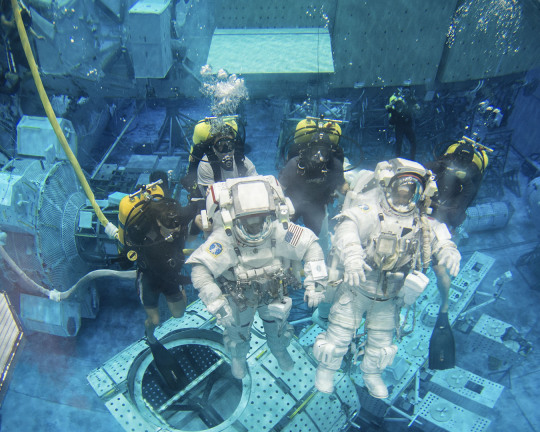
I think they gave up on giving us accurate calendars after the "10 year time skip" situation in chapter 215…

This tube is to prevent contaminating the astronauts so they don't bring anything to the moon. It's more important for missions to extraterrestrial bodies than, say, missions to the ISS since the ISS is already contaminated by people and it's fairly self-contained.
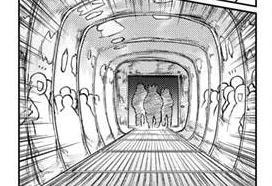
These space suits look more similar to atmospheric diving suits, especially JIM suits, than the softer-looking space suits we're used to. This might be because they lack the ideal materials, or possibly to avoid the problem of decompression sickness:

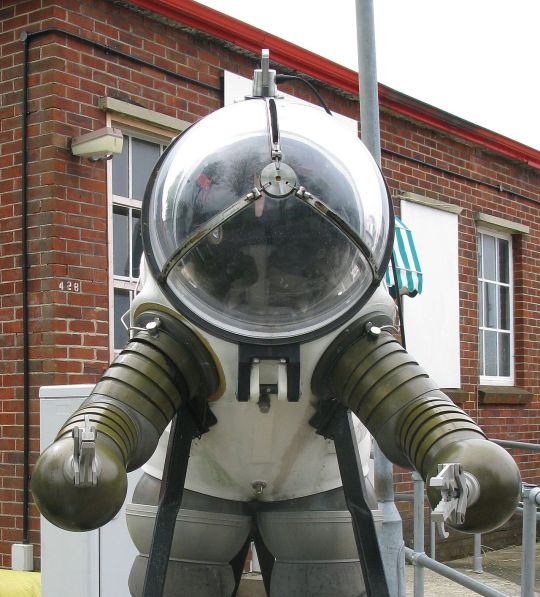
Hard-shell suits can withstand more pressure, so there's no need to adjust to the lower-pressure limits of the soft suits moving to/from the rocket. The other advantage to these suits is that there's no counter-force: the astronauts don't have to exert force to hold a position.
The suits are probably inspired by the RX series by Litton Industries, in particular the RX-2 (which had aluminum joints) and the RX-3, both from the 1960s.
Other space suits can be found here.


The udder-like valves at the front of the suit are for the various hose connections needed, such as breathable air and water cooling. You may notice that they're at similar positions to Stanley's revival outfit (probably a coincidence).
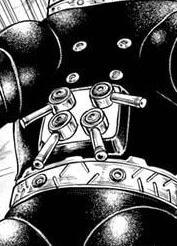
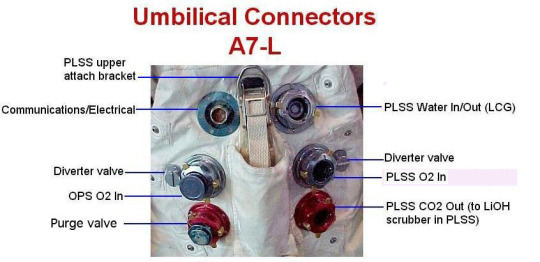
You're probably laughing at how awkwardly everyone's standing, and that's because the suits don't have a full range of movement. To make working with their hands easier, the suits are biased towards the front.
Shoulders are really complicated joints!


Remember last week when I said the gloves need to be fitted well so the wearers can use their hands properly?
I'm not even sure anyone can form a fist, let alone shoot a gun.



There's no visual difference between the suits, so once everyone has their helmets on it might be hard to tell who's who.
Unless the black and white manga is preventing us from seeing that they're bright red, blue, and green or something.
The transition from Stanley and Xeno being an inseparable pair, chasing their other half around the world, to Stanley admitting that "it ain't just the two of us anymore" really shows character development.
Xeno following it up with "we" makes me feel something though… 🥺


Xeno gives Stanley a pack of chewing tobacco because he can't smoke in space, but chewing tobacco needs to be spat out afterwards unless Stan intends to eat the cigarette, paper and all.
I really hope we see Stanley use one because I don't know how they're meant to work.

As of March 2021, in-flight accidents have killed 15 astronauts and 4 cosmonauts, making the fatality rate 3.2%. However, if you include the Apollo 1 launch pad fire that happened on the ground, this brings the total to 22/439 astronaut fatalities, which is the 5% Senku mentions.

(Next part)
13 notes
·
View notes
Text
NASA's Neutral Buoyancy Lab: The Ultimate Underwater Simulator for Astronauts
NASA’s Neutral Buoyancy Lab (NBL) is a state-of-the-art underwater facility located in Houston, Texas. It serves as an underwater simulation environment for astronauts to train for spacewalks and other extravehicular activities (EVAs). The NBL is one of the most advanced training facilities in the world and plays a critical role in preparing astronauts for the challenges they will face in space.
The NBL is a massive indoor pool that is over 200 feet long, 100 feet wide, and 40 feet deep. It contains a full-scale mock-up of the International Space Station (ISS) and other space structures, allowing astronauts to practice and perfect their spacewalking techniques in a controlled and safe environment. The pool is filled with over 6 million gallons of water, which provides a simulated weightless experience similar to that of space.
Astronauts are equipped with a full spacewalk suit, which provides them with life support and protection from the harsh conditions of space. The suit is buoyant, which makes it difficult for astronauts to move around in water. To overcome this challenge, the suit is weighted with lead weights to balance out the buoyancy, making it possible for astronauts to move around freely in the water. This process of weight balancing is called "neutral buoyancy," which gives the NBL its name.
The NBL is not only a training facility for spacewalking, but it is also used to test new spacewalk equipment and procedures. It allows engineers and scientists to observe how equipment and procedures perform in a simulated microgravity environment. This information is then used to make improvements and ensure the safety of astronauts in space.
One of the unique features of the NBL is its ability to simulate various lighting conditions, including daylight, nighttime, and the red lighting that is used during spacewalks. This capability allows astronauts to train for all types of spacewalking scenarios and ensures that they are well-prepared for any situation they may encounter in space.
In conclusion, NASA's Neutral Buoyancy Lab is a crucial component of astronaut training and space exploration. It provides a safe and controlled environment for astronauts to train for spacewalks and other EVAs, while also allowing engineers and scientists to test new equipment and procedures. The NBL plays a vital role in ensuring the success and safety of NASA's space missions.



#nasa#space#solarsystemambassador#iss#stem#moon#internationalspacestation#explorepage#artemis#spaceflight#johnson space center#astronaut#training#spacewalk#EVA
2 notes
·
View notes
Text
Season 5, Episode 12: Diving Into NASA History
In honor of National Intern Day, Gravity Assist features Felicia Ragucci, an undergraduate at Dartmouth College who recently completed an internship with NASA’s History Office and the Office of the Chief Scientist. During her time at NASA, Felicia researched the history of the Neutral Buoyancy Simulator, an underwater training facility where astron

View On WordPress
0 notes
Text
Space habitat reports – May.6.2024
Here is this week's selection of videos and news items about space habitats, living in space, and space settlement.
=== International Space Station & NASA
https://youtu.be/zowLYdbSBG4
** Space Station Crew Talks with Syracuse.com - The Post-Standard - Friday, May 3, 2024 - NASA Video
Aboard the International Space Station, Expedition 71 Flight Engineers Jeanette Epps and Matt Dominick of NASA discussed life and work aboard the orbital outpost during an in-flight interview May 3 with the Post-Standard/Syracuse.com. Epps and Dominick are in the midst of a long-duration mission aboard the microgravity laboratory to advance scientific knowledge and demonstrate new technologies for future human and robotic exploration flights as part of NASA’s Moon and Mars exploration approach, including lunar missions through NASA’s Artemis program.
https://youtu.be/aNHLii4p2MY
** SpaceX Crew-8 Dragon relocation - SciNews
SpaceX’s Crew-8 “Endeavour” Crew Dragon spacecraft, with NASA astronauts Matthew Dominick, Michael Barratt, Jeanette Epps and Roscosmos cosmonaut Alexander Grebenkin, was relocated from the forward-facing port to the space-facing port of the International Space Station’s Harmony module, on 2 May 2024. The relocation was performed in order to make way for the arrival of for the CST-100 Starliner spacecraft on Boeing’s Crew Flight Test, currently scheduled for 6 May 2024. The “Endeavour” Crew Dragon previously supported the Demo-2, Crew-2, Ax-1 and Crew-6 missions.
Credits: NASA/SpaceX
https://youtu.be/b7G5SCvJQ7o
=== Commercial space habitats
** Axiom Space tests their lunar spacesuit in the Neutral Buoyance Laboratory at NASA's Johnson Space Center in Houston:
.@Axiom_Space recently tested its AxEMU lunar spacesuit for the first time at @NASA's Neutral Buoyancy Laboratory. The uncrewed suit was submerged underwater to simulate the 1/6th gravity environment of the Moon to test its pressure garment system. Future testing at the pool will… pic.twitter.com/z4BODTJ7xZ
— NASA's Johnson Space Center (@NASA_Johnson) April 30, 2024
** Testing underway for Axiom's "Axiom Extravehicular Mobility Unit (AxEMU)" space suit for lunar surface activities:
With the successful conclusion of this trial run, the next NBL suit run will have our very own astronaut inside ... stay tuned!
Learn more about the #AxEMU, our next-generation spacesuit that will support humanity's return to the moon at https://t.co/eP6HiSUy2E
— Axiom Space (@Axiom_Space) April 29, 2024
** Sierra Space shows the development path for their inflatable space stations
Our company is leading the charge towards a science and biopharma platform designed to allow humans to live and work in LEO and beyond. As the ISS heads towards retirement, the future of space will revolve around the first commercial space station.https://t.co/FttqPaibeJ pic.twitter.com/Z0GOEJJXyw
— Sierra Space (@SierraSpaceCo) May 1, 2024
See the blog post at Building the World’s First Commercial Space Station | Sierra Space - Apr.30.2024
Our LIFE (Large Integrated Flexible Environment) technology launches on a conventional rocket. Its inflatable structure remains tightly packed upon deployment. One of the first in our product line, LIFE 285, will inflate into a structure that is three stories tall and 27 feet in diameter once it reaches space—essentially the size of a three-story apartment, with each floor being nine feet tall.
The inflatable structural shell is made up of a tightly woven fabric (Vectran) that’s up to five times stronger than steel once inflated and offers a balance of properties unmatched by other high-performance fibers. This strong structural shell, as well as its spacious interior, makes it perfect for both LEO and long-duration missions to the moon, Mars and the stars.
Why an inflatable softgoods shell? The problem with large, metallic space stations is that they’re hard (and expensive) to launch into space. That’s where the magic of an inflatable spacecraft comes into play. Launched in a packed state, it can easily reach space and expand to huge volumes.
Once fully inflated, the interior of LIFE 285 will be able to accommodate anywhere from four to twelve people, depending on the purpose and length of the mission.
It can also be fully packed with essential supplies and work space tools, including an Astro Garden® for a constant supply of fresh produce, ample sleeping quarters, a medic chamber, and exercise equipment. It will help serve as a place where innovations and groundbreaking research come together for longer duration space missions.
---- Sierra continues pressure tests of the inflatable module structures:
#ICYMI: We will be conducting our second full-scale structure test of our expandable space station technology next month at @NASA_Marshall in Huntsville, AL.
Stay tuned. pic.twitter.com/2xbePlA89o
— Sierra Space (@SierraSpaceCo) May 3, 2024
** VAST
Excited to show that we are building the world’s first commercial space station @vast Haven-1! This month we completed our VAST Haven-1 primary structure pathfinder which proved we could build in house all the critical geometries, transitions, and interfaces of Haven-1. Next up -… pic.twitter.com/uF73g79wry
— Max Haot (@maxhaot) April 29, 2024
=== Chinese space habitats
** Shenzhou-17 undocking - SciNews
The Shenzhou-17 (神舟十七) crew spacecraft undocked from the Tianhe Core Module (天和核心舱), departing the China Space Station (中国空间站), on 30 April 2024, at 00:43 UTC (08:43 China Standard Time). The Shenzhou-17 spacecraft is expected to make a parachute-assisted landing at the Dongfeng landing site, Inner Mongolia Autonomous Region, China, returning the sixth crew of three astronauts on a mission to the China Space Station (中国空间站): Hongbo Tang (汤洪波, commander), Shengjie Tang (唐胜杰) and Xinlin Jiang (江新林).
https://youtu.be/KBPKYrr6tpk
** Research Aboard China Space Station to Probe Origins of Life - CCTV Video News Agency
The China Space Station will undertake a number of new experiments during the Shenzhou-18 mission that may help answer key questions about the origins of life and work toward breakthroughs in medicine and spaceflight engineering.
https://youtu.be/xbd3GnEi3vo
=== Lunar habitation
** DARPA-backed study examines architectures for lunar bases.
The Lunar Surface Innovation Consortium (LSIC) is a NASA supported organization based at Johns Hopkins Applied Physics Lab (JHU/APL). LSIC recently hosted a meeting for DARPA's 10-Year Lunar Architecture (LunA-10), a seven month program that
aims to rapidly develop foundational technology concepts that move away from individual scientific efforts within isolated, self-sufficient systems, toward a series of shareable, scalable systems that interoperate — minimizing lunar footprint and creating monetizable services for future lunar users.
Participant teams in LunA-10 presented their findings at the LSIC meeting. Here, for example, are some slides from SpaceX, which presented plans for development of a lunar base using Starships:
Some SpaceX charts showing how the company believes it can use Starship to establish a lunar base (from its DARPA LunaA-10 study, being discussed today at the LSIC meeting.) pic.twitter.com/NPRc2UoiD4
— Jeff Foust (@jeff_foust) April 25, 2024
Presentations from all the teams are available in this document (pdf).
For even more about lunar base technologies, see the presentation, NASA Lunar Surface Operations & Power Grid (pdf), given by Jeffrey Csank of NASA Glenn Research Center at a 2023 meeting.
** China is Building a Lunar Satellite Constellation - Dongfang Hour - YouTube
As China ramps up its lunar exploration program in the coming decade, space-based lunar infrastructure is going to be a key enabler. Spacecraft and ground-based vehicles will increasingly need positioning and communication services, which is why China has launched a plan to establish a lunar satellite constellation called the "Queqiao constellation". The focus on the back side and the lunar south pole also means that communications will require relay satellites.
In preparation for this lunar constellation, expected in the 2030s, China has been launching single Queqiao spacecraft: the "Queqiao" in 2018, "Queqiao-2" in March 2024, and "Queqiao-3" by the end of the decade.
In this video, we cover this quest for lunar infrastructure, a low key but essential milestone for the establishment of China's future lunar outpost, the ILRS.
If you like what you see and would like to support me, please consider joining our small Patreon community at / dongfanghour !
We also have some very cool space merch available at https://shop.dongfanghour.com .
00:00 Introduction
00:17 Lunar exploration & tidal locking
01:11 Queqiao-1 and Queqiao-2 relay missions
03:11 Launching the Queqiao lunar constellation
05:47 Equivalent projects by NASA and ESA
https://youtu.be/hrnEIvPoTT4
See also China’s Next Moon Lander – Ready for Sample-collecting Sendoff | Leonard David - Apr.28.2024.
** China unveils international moon base concept animation - VideoFromSpace
China has unveiled a concept video for a international research base on the moon.
https://youtu.be/2YOvsJXsAQE
=== Mars habitation
- NASA Selects Commercial Service Studies to Enable Mars Robotic Science | NASA - May.3.2024
- Starlink on Mars? NASA Is Paying SpaceX to Look Into the Idea | Universe Today - May.3.2024
=== Future space habitat designs
** How Robots Will Help Humans Conquer The Moon - Fraser Cain
When humans will return to the Moon they will need a lot of assistance to set up a settlement and carry out all the missions. They will need a lot of robots to do that. How exactly will it pan out? Figuring out with Professor Yang Gao from King's College London.
https://youtu.be/j4K75MIlRz0
** When you hear "Bernal Sphere"... - SSI: Space Studies Institute Youtube - SSI Website
Just a little video for fun.
Oh, and this design isn't public domain. Just sayin'. Credit where credit is due please, and Thank you.
Want to know the story of "The Model"? Look here: https://ssi.org/an-oneill-colony-in-s...
And scroll down to the bottom to see what is and what is not a "Bernal Sphere" ...and why.
https://youtu.be/KqKxFPv7qvk
** Jerry Stone illustrates Island 0, a Gerard O'Neill Island 1 demonstrator - Space Renaissance
Jerry Stone illustrates Island 0, a Gerard O'Neill Island 1 demonstrator, in the frame of the Expanding Humanity To Outer Space International Cooperation Youth Event (EHTOS)
Moderator: Ghanim Alotaibi
Lecturer: Jerry Stone
Participants: Werner Grandl, Guy çignolet, Mahhad, B. Daniel, Adriano V. Autino
https://youtu.be/HxOv2Q9B6Jw
=== Polaris Program - SpaceX EVA suit unveiled. Will be used on first Polaris mission
On May 4th, the Extravehicular Activity (EVA) Suit designed by SpaceX was unveiled to the public. The initial application of the suit will be during the Polaris Dawn mission, which aims to reach the highest altitude yet for a Dragon spacecraft. They will attempt also to carry out the first EVA by private astronauts.
At approximately 700 kilometers above the Earth, the crew will attempt the first-ever commercial extravehicular activity (EVA) with SpaceX-designed extravehicular activity (EVA) spacesuits, upgraded from the current intravehicular (IVA) suit. Building a base on the Moon and a city on Mars will require thousands of spacesuits; the development of this suit and the execution of the EVA will be important steps toward a scalable design for spacesuits on future long-duration missions.
The Dragon has no airlock so when the hatch is opened, all four crew members must be in suits.
- SpaceX unveils Extravehicular Activity suit to be used during Polaris Dawn mission | Polaris Program - May.4.2024
- Online chat with the Polaris Dawn crew and SpaceX team | X.com - May.4.2024
- The Extravehicular Activity (EVA) Suit | SpaceX Updates - May.4.2024
- SpaceX - Human Spaceflight - Description of the SpaceX suits for intravehicular and extravehicular activities.
More @SpaceX photos of the new Extravehicular Activity (EVA) suit the Polaris Dawn crew will wear during their upcoming mission. Let us know your questions below ahead of today’s X Spaces event with the crew and SpaceX team https://t.co/tLdnzAVtCS pic.twitter.com/2ptb2IuQJo
— Polaris (@PolarisProgram) May 4, 2024
=== The Extravehicular Activity (EVA) Suit - SpaceX Youtube
At ~700 km above Earth, the EVA suit will support the Polaris Dawn crew in the vacuum of space during the first-ever commercial astronaut spacewalk.
Evolved from the Intravehicular Activity (IVA) suit, the EVA suit provides greater mobility, a state-of-the-art helmet Heads-Up Display (HUD) and camera, new thermal management textiles, and materials borrowed from Falcon’s interstage and Dragon’s trunk.
Building a base on the Moon and a city on Mars will require millions of spacesuits. The development of this suit and the execution of the spacewalk will be important steps toward a scalable design for spacesuits on future long-duration missions as life becomes multiplanetary.
https://youtu.be/fdELVCg2Ank
=== Other space habitat and settlement news and articles:
- Calendar:
- Webinar: What It Will Take To Build Communities In Space | Beyond Earth Institute, April 25, 2024, 1:00-2:30 pm
- ISDC | International Space Development Conference, Los Angeles, CA, Thursday, May 23rd to Sunday, May 26th, 2024
- 13th annual International Space Station Research and Development Conference (ISSRDC 2024) - July 30-August 1, 2024, Boston.
- ISS:
- Crew Works Payloads and Training, Awaits Starliner Arrival | Space Station/NASA - May.3.2024
- Dragon Moves to New Port, Makes Way for Starliner | Space Station/NASA - May.2.2024
- ISS Roundup: an eclipse, an EVA, and more than just science returns to Earth| NASASpaceFlight.com - Apr.30.2024
- Dragon Spacecraft Splashes Down Completing Resupply Mission | Space Station/NASA - Apr.30.2024
-
Read the full article
0 notes
Link
Considerable effort goes into the design of space suits and space agencies across the world are always working on improvements to enhance safety and mobility of the designs. NASA is now working with Collins Aerospace to develop their next generation spacesuit for the International Space Station. The new designs are tested extensively and recently, the new design was subjected to a ZeroG flight on board a diving aircraft. Collins Aerospace are an American technology company based in Charlotte in North Carolina. They were selected to develop the new suit as a replacement to the existing garments used by NASA. The official name of the suits are extravehicular mobility units and they have been worn for over two decades. Once a prototype for the new suit was developed the project entered its test phase with one of the key elements, the microgravity or ZeroG test. To simulate ZeroG aircraft are taken on a parabolic flight. The pilot takes the plane to an altitude of around 24,000 feet and then pulls up increasing the climb angle to 45 degrees. Reaching an altitude of about 32,000 feet the plane is then put into a dive where the plane and its occupants experience ZeroG. For those inside, they will float around for between 20 and 30 seconds. The only people who’ll be floating above the floor on January 4th are the astronauts on board the International Space Station. This photo shows onboard the NASA KC-135 that uses a special parabolic pattern to create brief periods of microgravity During this time of simulated weightlessness, engineers, scientists and students on board can conduct experiments in a space-like environment without having to venture into space. It was during a flight like this that the prototype was tested to ensure it met all system and safety requirements. Following on from the ZeroG flight test, Collins will continue on to the next test by subjecting it to a vacuum within a specialised chamber to simulate the vacuum of outer space. Additional tests will see the suit submerged into NASAs Neutral Buoyancy Laboratory which is a 13m deep pool in Houston. Within this facility further microgravity like conditions will be experienced and it is here that astronauts train for spacewalks before heading out into space. Hubble Servicing Mission astronaut training in the water of the Neutral Buoyancy Lab in Houston, Texas, February 2009. Credit and copyright: Michael Soluri. Once its ready for service, the suit will further enhance NASA’s extravehicular (activities outside spacecraft) capability while in low Earth orbit. Astronauts will use it to support International Space Station maintenance tasks to ensure its continued operations and development. Source : Collins Aerospace Tests NASA Space Station Suit in Weightlessness The post Next Generation Spacesuit Gets Tested in Weightlessness appeared first on Universe Today.
0 notes
Photo
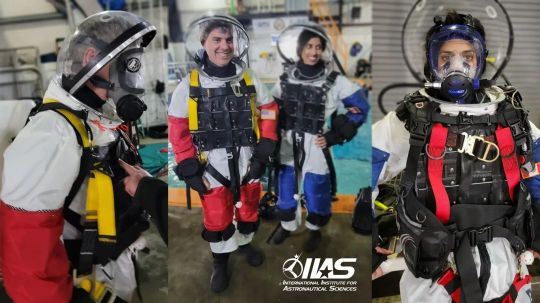
Neutral buoyancy in water is used by space agencies around the word for EVA training, spacesuit evaluation, development of human-robotic partnership protocols and many other simulations. It specializes in development of tools, techniques, equipment and scientific experiments for this extreme space analog. Last week we had a test at International Institute for Astronautical Sciences (IIAS) Neutral Buoyancy Lab at Survival Systems USA facility of the new training spacesuit developed by the brilliant Cameron Smith and Trent Tresch . All the simulation development being checked step by step and following development protocols for the exercise and improvement of the training suit. The experiment was performed by our talented Shawna Pandya, MD and Brien Posey from IIAS who completed 3 simulations for 6 hours underwater in a low-light orbital environment (see photos) repairing a defective module outside the airlock. The communication system was in charge of our commanders Richard Blakeman and Guadalupe Espinoza-Gastelum . The ground safety check was executed by Trent Tresch , Aaron Persad, Cameron Smith , Chris Lundeen and me (in a small roll here!). The water safety and rescue (so that all this complicated process could run smoothly and no harm) was done by the incredible team of Survival Systems USA. The work performed was impressive and even more so with this amazing team (I mean family #spacefam). Thanks @trenttresch, @shawnapandya, Aaron Persad, @gypsynaut, @therealbrienposey and cameron for including me in this fantastic experience in testing this new spacesuit for our courses. Count on me always. #team #work #experience #training #development #safety #communication #environment #water #astronaut #astronautlife #spacecraft #spaceexploration #moonwalk #marsexploration (at Survival Systems USA, Inc.) https://www.instagram.com/p/CkFEMrXIDhX/?igshid=NGJjMDIxMWI=
#spacefam#team#work#experience#training#development#safety#communication#environment#water#astronaut#astronautlife#spacecraft#spaceexploration#moonwalk#marsexploration
0 notes
Text
Kill the lights – We’re Simulating a Moonwalk!
At the bottom of a very dark swimming pool, divers are getting ready for missions to the Moon. Take a look at this a recent test in the Neutral Buoyancy Laboratory at NASA’s Johnson Space Center.
NASA astronauts are no strangers to extreme environments. We best prepare our astronauts by exposing them to training environments here on Earth that simulate the 1/6th gravity, suit mobility, lighting and lunar terrain they'll expect to see on a mission to the Moon. Practice makes perfect.
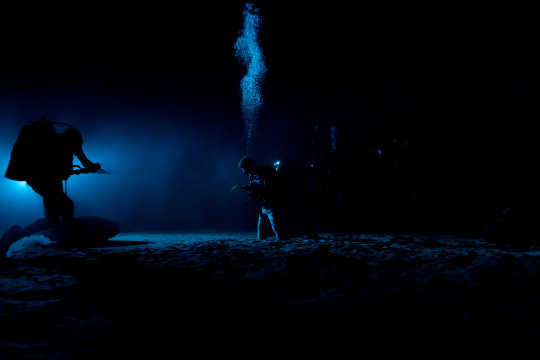
The Neutral Buoyancy Laboratory at NASA's Johnson Space Center is where astronauts train for spacewalks, and soon, moonwalks.
When astronauts go to the Moon’s South Pole through NASA’s Artemis program, the Sun will only be a few degrees over the horizon, creating long, dark shadows. To recreate this environment, divers at the lab turned off the lights, put up black curtains on the pool walls to minimize reflection, and used powerful underwater lamps to simulate the environment astronauts might experience on lunar missions.
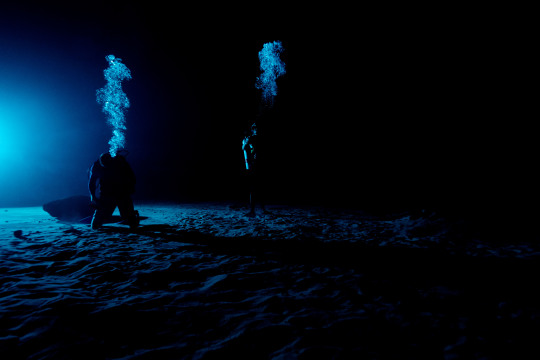
These conditions replicate the dark, long shadows astronauts could see and lets them evaluate the different lighting configurations. The sand at the bottom is common pool filter sand with some other specialized combinations in the mix.

This was a test with divers in SCUBA gear to get the lighting conditions right, but soon, NASA plans to conduct tests in this low-light environment using spacesuits.

Neutral buoyancy is the equal tendency of an object to sink or float. Through a combination of weights and flotation devices, an item is made to be neutrally buoyant and it will seem to "hover" under water. In such a state, even a heavy object can be easily manipulated, much as it is in the zero gravity of space, but will still be affected by factors such as water drag.
The Neutral Buoyancy Laboratory is 202 ft in length, 102 ft in width and 40 ft in depth (20 ft above ground level and 20 ft below) and holds 6.2 million gallons of water.
2K notes
·
View notes
Photo

NASA's Neutral Buoyancy Laboratory
Why would anyone want to keep over 23 million litres (6 million gallons) of water at a constant 30 degrees Celsius (86F)? To practice spacewalks of course!
The largest indoor body of water in the world measures 62x31m (202x101ft) and is over 12m (40ft) deep. Spread around the pool are life-size component mock ups of different sections of the International Space Station (ISS). The pool has also played host to mock-ups of other NASA spacecraft as well as vehicles from the Japan Aerospace Exploration Agency (JAXA), European Space Agency, SpaceX and Orbital Sciences Corporation.
The stats of the pool are phenomenal:
- it loses 18,000 litres of water, through evaporation, every week
- the entire pool of water is recycled every 19.6 hours
- the customised suits worn in the “tank” weigh over 100kg (two people are needed to help the astronaut don their pants)
- underwater simulations can last seven hours
Not even the surreal conditions of the Neutral Buoyancy Lab can prepare astronauts entirely for spacewalks on the ISS – water drag (which hinders motion) makes some tasks easier to perform in the Lab than on the ISS, but makes other tasks more difficult.
-CJ
Image: The Neutral Buoyancy Laboratory, Lee Hutchinson
Further Reading:
https://www.nasa.gov/centers/johnson/pdf/167748main_FS_NBL508c.pdf
https://arstechnica.com/science/2013/03/swimming-with-spacemen
https://www.discovermagazine.com/the-sciences/two-men-in-a-tub
#nasa#neutral buoyancy laboratory#pool#spacewalk#science#age of the universe#space suit#iss#the real universe#isuniverse
23 notes
·
View notes
Text
Have you got what it takes to become an astronaut in the new era of human spaceflight?
by Adam Hawkey
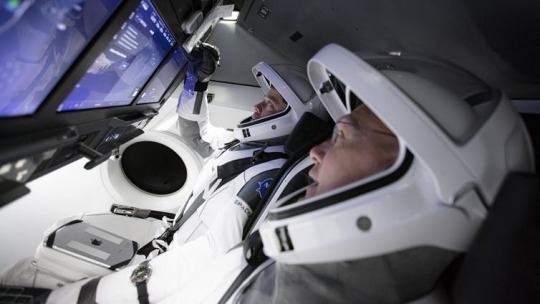
Astronauts Bob and Dough made it to the International Space Station in a privately funded vehicle. NASA
Millions of people watched breathlessly as astronauts for the first time successfully travelled to the International Space Station (ISS) in a privately funded spacecraft, SpaceX’s Falcon 9 rocket and Crew Dragon capsule, on May 30. The historic launch, which marks a new chapter in human spaceflight, is likely to lead to renewed interest in spaceflight.
So, what exactly does it take to become an astronaut? And can we expect the requirements to change as more private companies get involved and we go on longer journeys?
During the space race of the 1960s, NASA selected an elite group of air force and test pilots to orbit the Earth and to ultimately land on the moon. These pioneers were well accustomed to taking risks and pushing their hardware to the limit. They were later described as having “The Right Stuff” when it came to the physical and psychological characteristics required to be a space farer – a term that is now synonymous with astronaut selection.

Crew dragon docks with the ISS. NASA
Nowadays, thanks to advances in technology and a greater understanding of the requirements of spaceflight, scientists, doctors, engineers and even journalists have all joined the most exclusive club on (and off) Earth. Of the estimated 100 billion people who have ever lived, fewer than 600 individuals have travelled into space. It is therefore a unique profession and one that not all of us are suited to.
Current criteria
Currently, NASA stipulates that applicants must meet certain criteria. First, you must be a US citizen, though some have changed their nationality to fulfil this requirement – including UK-born Michael Foale and Piers Sellars.
You must also possess a master’s degree in science, technology, engineering, or maths, or a Doctor of Medicine degree. In addition to that, you should have at least two years of related professional experience. Alternatively, 1,000 hours of pilot-in-command time on a jet aircraft will do, which is particularly important for the pilot and commander roles. And finally, you have to pass NASA’s long-duration flight astronaut physical test.
Similar criteria are set by other nations, including the European Space Agency (ESA). Essentially, candidates must demonstrate aptitude in a range of attributes. These can generally be broken down into four distinct areas, and may change going forward.
Education: The pilot and commander roles for a space mission will always favour those from a military/test pilot background. But modern spaceflight crews have to undertake a far wider range of duties pertaining to science and engineering than their pioneering predecessors. While on the ISS, crews have to ensure the integrity of experiments and keep the station operating efficiently and safely. Therefore, having a detailed knowledge of scientific processes and engineering principles is essential and will continue to be so.
Psychology: Emotional stability is a crucial trait for any astronaut to have, but the psychological requirements are much more comprehensive than simply controlling one’s emotions. An ability to demonstrate good reasoning, high levels of concentration and memory, spatial orientation (especially crucial when there is no up or down in space) and manual dexterity are also important factors.
With longer-term flights to the ISS and eventually Mars planned, it will be increasingly important for astronauts to be able to work well as a member of a team, be flexible in their approach to resolving problems and have empathy for their fellow crew.
Physical: Whether it be due to the high g-forces during launch or the microgravity environment in Earth orbit, the human body is pushed to its limit throughout a spaceflight mission. Therefore, it is fundamental to mission success that astronauts are medically and physically capable of surviving such diverse and challenging conditions.
In addition to successfully enduring a barrage of physical fitness tests, astronauts must also have 20/20 eyesight (correction allowed) and a seated blood pressure of 140/90 or below. While there is technically no age restriction, the average astronaut candidate is around 34 years old. So long as you are fit enough there appears no limit to this – John Glenn flew on the space shuttle aged 77.
Training: To be able to go to space, astronauts also have to complete an assortment of activities designed to prepare them for the various aspects of their mission. Exposure to high speed manoeuvres in jet planes and increased g-force in specially constructed centrifuges prepare the astronauts for some of the physical challenges they will experience during launch and landing procedures.

Training in water. NASA
They also practice in-flight procedures like eating, drinking and using the lavatory during short periods (~25s) of simulated “zero-g” flights using converted passenger jets.
Longer periods of weightlessness can be created in vast swimming pools such as NASA’s Neutral Buoyancy Laboratory. There, astronauts, kitted out in full spacesuits, can train alongside full-size mock-ups of ISS modules. This allows crews to carry out run-throughs of upcoming missions.
Space tourism
The official space agency route to becoming an astronaut is no longer the only way to get a ticket into space though. Since the early 2000s, the ISS has hosted private paying guests. The success of NASA’s Commercial Crew Program will continue to facilitate safe, reliable and cost-effective access to and from the ISS. This will likely include an increase in visiting private astronauts.
As these guests will not be as “hands-on” as their fellow astronauts, they will not have to fulfil as stringent criteria. This will likely allow more people access to space. However, this private option will not come cheap. NASA estimates that, in addition to launch costs, these space tourists can expect to pay around US$35,000 per night.
Becoming an astronaut is probably, and not surprisingly, one of the most difficult career paths to pursue. That said, those who have achieved their astronaut “wings” describe it as a hugely rewarding profession. So, if you have the required passion and related characteristics then perhaps you too have The Right Stuff.

About The Author:
Adam Hawkey is Associate Professor in the School of Sport, Health and Social Sciences at Solent University
This article is republished from our content partners over at The Conversation under a Creative Commons license.
8 notes
·
View notes
Text
Space Station 20th: Six Months Until Expedition 1
ISS - International Space Station 20th Anniversary patch.
April 8, 2020
With their anticipated ground-breaking launch to the International Space Station (ISS) just six months away, the Expedition 1 crew of Commander William M. Shepard, Flight Engineer Sergei K. Krikalev, and Soyuz Commander Yuri P. Gidzenko as well as their backups Kenneth D. Bowersox, Mikhail V. Tyurin and Vladimir N. Dezhurov divided their time between Russia and the United States. In April 2000 they took a side trip to Germany to familiarize themselves with one of the collaborative science experiments for their mission. In both the United States and Russia, engineers prepared the next modules and elements to be added to the still embryonic space station.
Two views of Expedition 1 commander Shepherd during an EVA training
session in the Hydrolab facility at Star City in February 2000. Images Credit: NASA.
The Expedition 1 prime and backup crews began the year 2000 with the astronauts training in the U.S. and the cosmonauts in Russia. They spent February training together in Russia, mainly at the Gagarin Cosmonaut Training Center in Star City outside Moscow, among other things practicing for Extra-Vehicular Activities (EVAs) or spacewalks using the Russian Orlan spacesuits in the Hydrolab facility. In March, they trained at the Johnson Space Center (JSC) in Houston, conducting EVA training in the Neutral Buoyancy Laboratory and joint simulations with Shuttle crews. In April they returned to Star City for additional training on Russian segment and Soyuz spacecraft systems.
Above: Expedition 1 crewmembers (left to right) Shepherd, Krikalev, Gidzenko, Dezhurov and Tyurin pose in front of the Plasma Kristall experiment hardware. Middle: The Plasma Kristall experiment hardware. Bellow: Expedition 1 crewmembers pose with the international Plasma Kristall experiment team. Images Credit: Max Planck Institute.
Unlike subsequent expeditions, the Expedition 1 crew had a somewhat modest amount of science experiments to conduct due to the priority placed on station assembly. The Plasma Kristall-3 (PK-3) experiment, later renamed PKE-Nefedov to honor Anatoli P. Nefedov, the Russian co-principal investigator who passed away in 2001, was one of the first natural science experiments conducted on the space station. The Max Planck Institute for Extraterrestrial Physics in Garching near Munich, Germany, and the Institute for High Energy Densities in Moscow, part of the Russian Academy of Sciences, collaborated on the experiment to study the formation and behavior of plasma and dust crystals in microgravity. Earth-bound benefits from research in plasma crystals include improved means of disinfecting surfaces including wounds, aiding in the healing process. In April 2000, five of the six Expedition 1 crewmembers (Bowersox was not available) traveled from Moscow to Germany to train on the PK-3 experiment.
Above: ISS as it appeared in May 1999, with the Zarya module at left and the
Unity Node 1 at right. Bellow: The Zvezda Service Module at RKK Energia being prepared for shipment to Baikonur in April 1999. Images Credit: NASA.
On-orbit assembly of the still crew-tended ISS, begun in November 1998, was ready to continue in mid-2000 with the launch of the Russian-built Zvezda Service Module (SM), providing living accommodations for long-duration crews, including environmental control and life support equipment. The Khrunichev State Research and Production Space Center in Moscow built Zvezda and delivered it to RKK Energia’s Test and Checkout Facility in 1998 so engineers there could begin extensive testing. In May 1999, workers transported the module to the Baikonur Cosmodrome’s Area 254 for additional testing and to begin prelaunch preparations. On Feb. 10 and 11, 2000, senior managers from the U.S., Russia and the European Space Agency met in Moscow to review the status of the ISS program, in particular Zvezda’s readiness for launch. At the conclusion of the meetings, the managers established July 8 to 14 as the launch window for the module, with July 12 as the optimal date, pending recertification of the Proton rocket after a launch failure in October 1999. The recertification mandated two successful launches before Zvezda’s.
Above: STS-101 crew posing outside the Spacehab module. Bellow: Members of the STS-101 crew inspect equipment inside the Spacehab module. Images Credit: NASA.
With Zvezda’s launch date firmly set, on Feb. 18 NASA managers decided to split the next Shuttle resupply mission, STS-101 and designated as 2A.2 in the overall ISS assembly sequence, into two separate flights. The first kept the STS-101 number but was redesignated as 2A.2a and initially scheduled for April, three months prior to the arrival of Zvezda. Several delays caused the mission to slip to May. The second became a new flight, STS-106 and 2A.2b, with a planned launch date in August (ultimately flew in September) to begin outfitting Zvezda before the Expedition 1 crew arrived in early November. Both missions made use of a Spacehab pressurized module to transport supplies to ISS.
Above: MEIT underway in the SSPF – US Lab Destiny is in the framework at right, the Z1 truss is at left. Middle: Controllers monitor the MEIT. Bellow: Astronauts inside the Destiny module during the MEIT – ISS Expedition 2 crewmember James S. Voss (upper left) and STS 98 crewmembers Kenneth D. Cockrell (lower left) and Mark L. Polansky (upper right). Images Credit: NASA.
In the United States, several ISS elements had already arrived at Kennedy Space Center’s Space Station Processing Facility (SSPF) for preflight testing. These elements included the Destiny U.S. Laboratory module, the third Pressurized Mating Adaptor (PMA-3), several segments of the Integrated Truss Assembly, and the Canadian-built Canadarm2 Space Station Remote Manipulator System. Engineers in the SSPF conducted a months-long Multi-Element Integrated Test (MEIT) to ensure that the various components worked well together before they reached orbit. They connected electrical and fluid lines among the Destiny module, the Z1 and P6 truss segments and the PMA-3 and used an emulator as a stand-in for the Unity Node 1 already on orbit. In February 2000, engineers completed an End-to-End Test and a Mission Sequence Test with the Destiny module, essentially duplicating the activation of the Lab once in orbit. Shepherd and several crewmembers of STS-98, the mission that delivered the Lab to orbit, took part in the tests, as did engineers at the Johnson Space Center and the Marshall Space Flight Center. The tests identified several issues that engineers fixed on the ground, preventing major problems that would have occurred only after the elements reached orbit.
To be continued…
Related articles & link:
Space Station 20th – Women and the Space Station
https://orbiterchspacenews.blogspot.com/2020/03/space-station-20th-women-and-space.html
Space Station 20th: Long-duration Missions
https://orbiterchspacenews.blogspot.com/2020/03/space-station-20th-long-duration.html
NASA Counts Down to Twenty Years of Continuous Human Presence on International Space Station
https://orbiterchspacenews.blogspot.com/2019/11/nasa-counts-down-to-twenty-years-of.html
20 memorable moments from the International Space Station
https://orbiterchspacenews.blogspot.com/2018/11/20-memorable-moments-from-international.html
International Space Station (ISS): https://www.nasa.gov/mission_pages/station/main/index.html
Images (mentioned), Text, Credits: NASA/Kelli Mars/JSC/John Uri.
Greetings, Orbiter.ch
Full article
8 notes
·
View notes
Photo
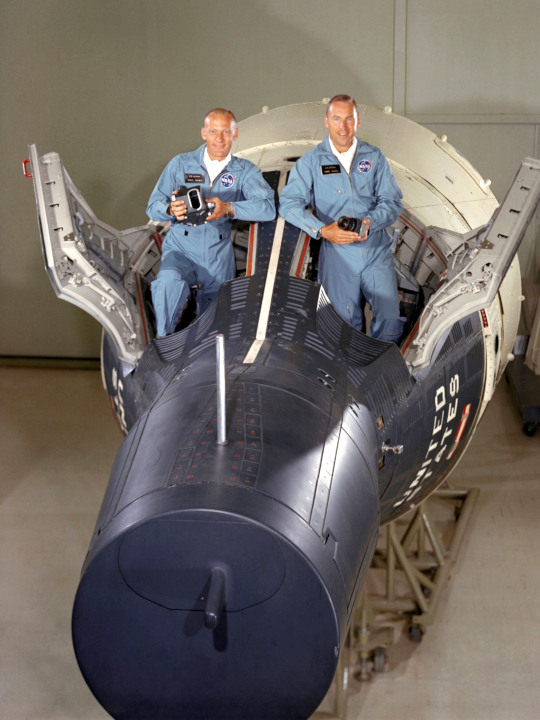


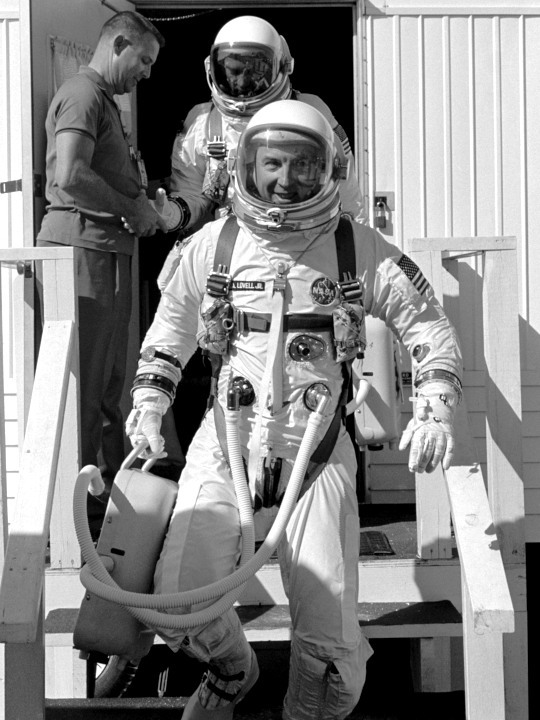

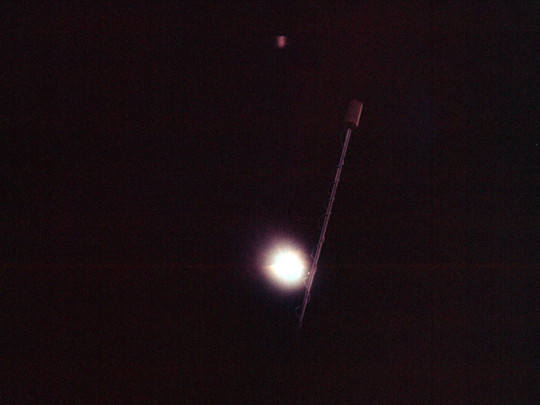
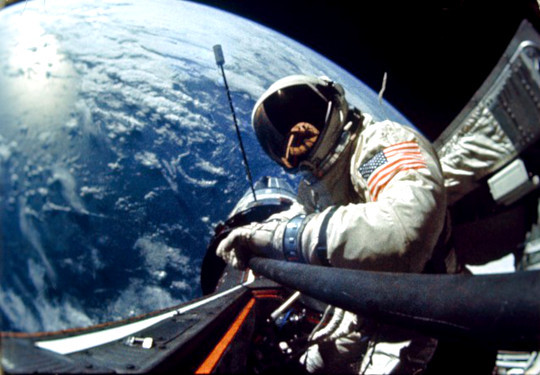
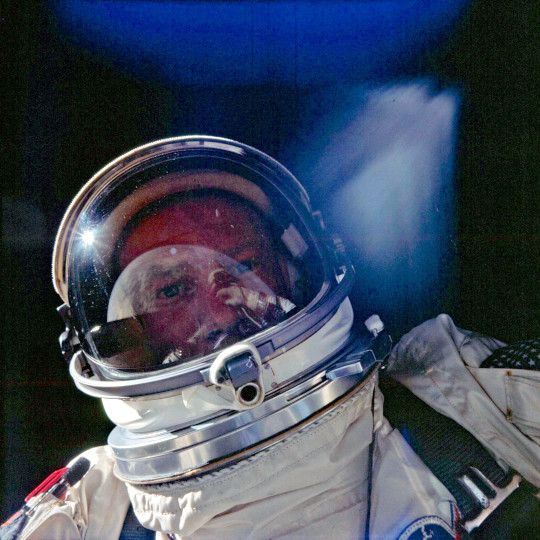
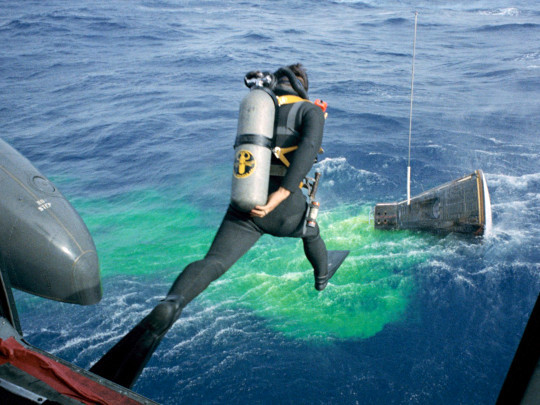

6. Gemini 12
Date: November 11-15, 1966 (3 days, 22 hours, 34 minutes, 31 seconds)
Crew: James A. “Jim” Lovell, Jr. and Edwin E. “Buzz” Aldrin, Jr.
Mission Highlights: The tenth and final flight of Project Gemini, Gemini 12 launched from the Cape on November 11, shortly after the successful launch of its prime target, the Agena Target Vehicle. The most pressing objective was to finally conquer the extravehicular activity, the spacewalk, an activity that American astronauts had struggled with for several flights. In order to improve the EVA experience, NASA implemented new training strategies including underwater training to simulate “neutral buoyancy” conditions in space.
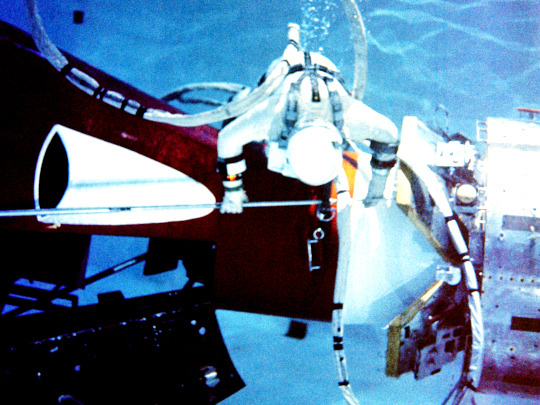
Rendezvous and docking took place on the first day. When onboard radar was lost, Buzz Aldrin, aka Dr. Rendezvous, manually calculated the necessary maneuvers and Gemini 12 successfully docked with the ATV.Buzz‘s first of three planned Gemini 12 EVAs was a stand-up EVA on the second day of the flight, meant to assist his next two. In addition to Earth photography, he installed a handrail near the hatch that would allow for easier movement and navigation when he left the spacecraft. The next EVA, on the third day, lasted over two hours. Buzz’s tasks included a gravity-gradient experiment with the docked Agena, testing equipment designed for use aboard Apollo flights, and simply managing a moderate workload without becoming exhausted or disoriented. Accomplishing all of those objectives, particularly the last, the EVA was a terrific success. Aldrin and others attributed EVA improvements to the underwater “neutral buoyancy” training that had replaced KC-135 zero-g training. The final EVA was another stand-up consisting of observational photography.
On November 15, the computer-controlled reentry put the crew of Gemini 12 right on target, a few miles from their landing site. They were recovered by the USS Wasp and treated for mild dehydration (and Jim had pinkeye), but otherwise healthy.
Significance: The conclusion of Project Gemini was an enormous milestone for NASA leading up to Apollo and the first moon landing. Gemini 12 accomplished its mission, most importantly proving that NASA had found the solutions to its the biggest spacewalking problems. Underwater training as well as an increase in well-placed handrails and restraints made productive EVAs less strenuous and more successful. This development was essential for the goals and objectives of the Apollo program.
Shortly after the flight, President Lyndon Johnson spoke on the legacy of Gemini and Apollo’s future: “Today's flight was the culmination of a great team effort, stretching back to 1961. It directly involved more than 25,000 people in the National Aeronautics and Space Administration, the Department of Defense, other government agencies, universities, other research centers and in American industry... The months ahead will not be easy, as we reach toward the moon, but with Gemini as the forerunner, I am confident that we will overcome the difficulties and achieve another success.”
#YAYYY GEMINI LOVE YA#jim lovell#buzz aldrin#astronauts#gemini 12#gemini#NASA#1960s#1966#*#apollo 50 countdown
83 notes
·
View notes
Note
Gordon thinking that John knows nothing about diving, etc, until John gives Gordon pointers, and he is right, and Gordon wants to know how John knows, and finding out about the NASA pools and what training John had to go through, and John kind of knowing what it's like to be trapped underwater.
I assume this is in response to my tags: #Gordon and John probably have the least in common of them all at the core of it. They’re like chalk and cheese. #The sun and moon. #Gordon is wild and exuberant; untameably colourful and John is quiet and clever; bleached out by life in space. #but gold rank in NASA pools is not as different from Gold in the Olympics as you’d think #and Gordon and John are as similar as they are different #Sea and Sky #at the core of it #they're both International Rescue blue
and i have a lot of fEELINGS about John and Gordon being so wildly different and yet so bizzarely similar.
The one thing they definately have in common is a shared interest in swimming. If Gordon can take advantage of that to see more of the brother he sees least of, then he sure as hell won’t pass up the opportunity to get John in the water. Of course John knows how to dive - he’s absolutely spent hours and hours repping scuba dives, simulating perfect EVA sessions, in his time at NASA. There are huge similarities between under the sea and being up out of the atmosphere. Both of them live their lives reliant on oxygen tanks and strict rules and the fear that if even the littlest thing could go wrong it could present a life threatening problem. John is so terrified for Gordon when he activates his emergency beacon because he knows what it’s like. He’s been there, floating helpless and weightless with his oxygen running rapidly out and having to rely completely on his own brothers to save him (Thanks for that Eos). But 22,400 miles into orbit there’s not a lot John, specifically, can do for Gordon, except to be the constant voice on the other end of the silent Comm line, praying to hear anything, anything at all, and that feeling of helplessness is about as crushing as the pressure of the depths of the sea and about ten tonnes of rocks.
So yeah, John is very used to neutral-buoyancy diving and its similarity to the weightlessness of space travel and if they’re going to take a swim off the reef they’re more likely to stick together as diving buddies than ever go alone. It’s their thing and Gordon really does need their thing because their spaceman’s really not home nearly often enough - to the point where it’s become almost weird to see him in the flesh, and not just as a pale blue hologram.
#I have a half written fic for these two that has a lOT of these feels#its over 100 pages though oh boy#when will len ever publish anything she writes probably never#sdlkfjgfdksl#i love these children tho#Lenle's Thunderbirds Tag#Thunderbirds#John Tracy#Gordon Tracy#duchessnibenhu-ofpyromania#im tired and should be in bed but I HAVE FEELS OK
17 notes
·
View notes
Photo
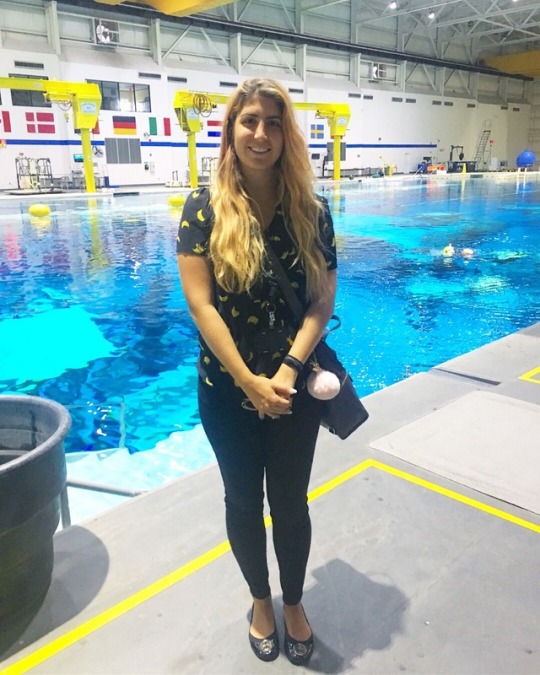
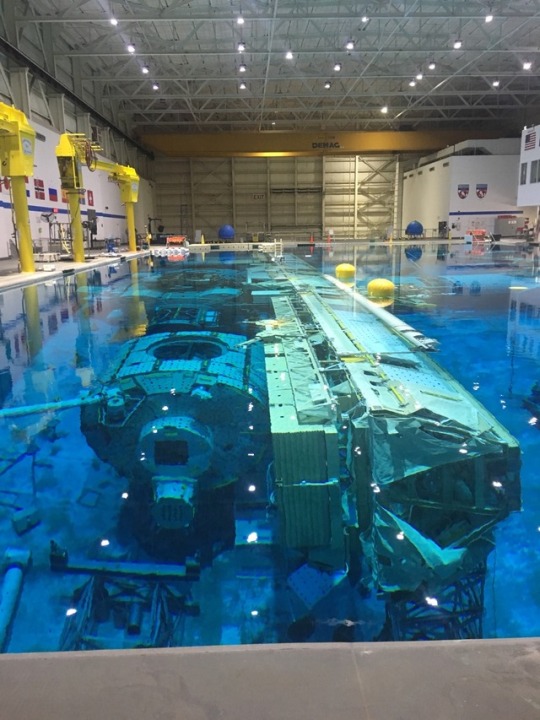
Guess who toured the neutral buoyancy lab today? This is where all the astronauts (except russian cosmonauts) train! The water helps simulate weightlessness when maneuvering things around practicing for spacewalks. You can see my full post on my instagram.
46 notes
·
View notes
Text
NASA leaves astronauts underwater without lights
NASA leaves astronauts underwater without lights
NASA is preparing astronauts for the day they explore the moon’s south pole by leaving it underwater without light.
Astronauts are rehearsing for spacewalks in a large swimming pool called the Neutral Buoyancy Laboratory, which acts as a simulation.
According to experts, underwater walks provide an experience close to the space environment, where gravity is limited.
Nasa officials, however, did…
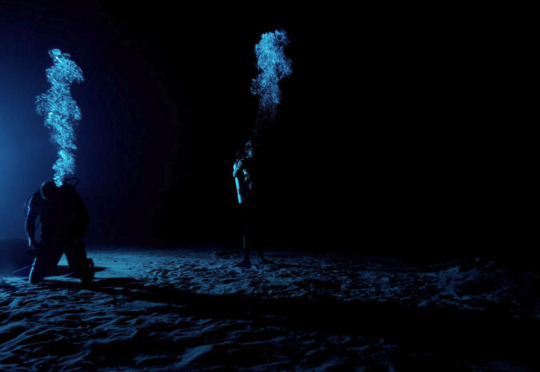
View On WordPress
0 notes
Link
A key NASA design milestone was recently completed by Collins Aerospace as the company works to develop a next-generation spacesuit for use on the International Space Station. The milestone – a pressure garment system fit and functionality test in a microgravity-like environment – marked an important step toward developing a suit for NASA that can be used for continuing operations and advancing scientific discovery in low Earth orbit. The agency selected Collins to develop a new spacesuit that can replace the current space station spacesuit, known technically as an extravehicular mobility unit, which has been worn by astronauts to assemble and maintain the space station for over two decades. The Collins test was conducted aboard a commercial microgravity aircraft to provide brief periods of weightlessness. During a parabolic flight, a pilot creates weightless conditions for around 20 seconds at a time by conducting a series of roller-coaster-like maneuvers. This allows engineers, scientists, and students to test hardware and conduct scientific experiments in a space-like gravity environment without ever going into space. Collins Aerospace completed a key NASA design milestone on the company’s next-generation spacesuit for use on the International Space Station. The test was conducted aboard a commercial zero-gravity aircraft where Collins performed a pressure garment system fit and functionality test in a microgravity environment.Collins Aerospace Collins Aerospace’s chief test astronaut John “Danny” Olivas demonstrates a series of tasks during testing of Collins’ next-generation spacesuit while aboard a zero-gravity aircraft. Collins Aerospace Collins Aerospace’s chief test astronaut John “Danny” Olivas demonstrates a series of tasks during testing of Collins’ next-generation spacesuit while aboard a zero-gravity aircraft. Collins Aerospace Collins Aerospace’s chief test astronaut John “Danny” Olivas demonstrates a series of tasks during testing of Collins’ next-generation spacesuit while aboard a zero-gravity aircraft. Collins Aerospace The test was a key step in NASA’s preliminary design review process, one of a series of checkpoints in the project’s design lifecycle, that ensures the design meets all system requirements before manufacturing of flight-ready units can begin. Collins will continue testing its spacesuit in a vacuum chamber, where air will be removed to create a vacuum to see how the spacesuit performs in a space-like atmosphere, as well as at the agency’s Neutral Buoyancy Laboratory, a 40-foot deep pool at NASA’s Johnson Space Center in Houston, that simulates a microgravity environment for astronaut spacewalk training. This next-generation spacesuit is designed to advance NASA’s spacewalking capabilities in low Earth orbit. It is being developed to support station maintenance and operations as NASA and its international partners continue carrying out scientific research that benefits humanity and demonstrates new technologies for future human and robotic missions.
0 notes